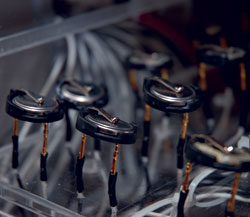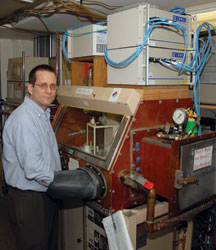More Bang for Your Battery
New nanotechnology launches longer lasting batteries.
By Kathleen Kocks

|

Jessica McConnell
|
Is the world becomes increasingly populated with mobile electronic
products, one of the most ubiquitous pieces of equipment is
the battery. From the watch on your wrist to satellites in
space, batteries are the enablers of the technology, powering
an array of products used in a wide range of applications.
While its design and performance have evolved since Italian
Count Alessandro Volta invented the battery in 1799, there’s
plenty of room for further improvement. Battery life, power,
recharging times, size, and weight are just a few parameters
that beg for upgrades. In fact, drawbacks in current battery
technology are impeding advancements in existing products—including
cell phones and laptop computers—and in new applications—such
as the electric car.
This is why GW Professor Michael J. Wagner and his team at
the Wagner Lab within the University’s Columbian College
of Arts and Sciences Department of Chemistry are leading a
charge to improve the battery.
An associate professor of chemistry, Wagner defines himself
as a scientist and nanoresearcher. He works in the world of
nanotechnology, which uses materials designed at the atomic
level (dubbed “nanomaterials”) to improve existing
technology, as well as create new technology. It is a scientific
field with explosive potential to change the world much as
semiconductors did. Nanotechnology is at the heart of Wagner’s
battery research.
“We began this research about five years ago, and the
simplest way to explain it is to say we are trying to find
better materials to make better batteries and improve their
performance,” Wagner explains.
“There are various measures that define battery performance.
One is energy density, which is a measure of how much energy
a battery can store. Another is storage life, which relates
to how long a battery remains charged. Another area is how
fast you can recharge a battery. And there is cycle life,
which relates to how many times you can recharge a battery
before it won’t recharge and has reached the end of
its service life.”
Introduced to the commercial market in 1991, lithium ion
(Li-ion) rechargeable batteries are among the three most prevalent
types of rechargeable batteries used in electronics today.
The other two types—nickel-cadmium (NiCad) and nickel-metal
hydride (NiMH)—are being or have been replaced by Li-ion
batteries in most applications.
Li-ion batteries work pretty much as any other battery does.
They contain lithium ions swimming in an electrolyte composed
of lithium salts and an organic solvent. The ions shuffle
between two electrodes: one of graphite (the negative electrode)
and the other of metal oxide (the positive electrode). As
the battery is charged, the ions are attracted to the graphite;
during discharging, the ions head for the metal oxide. Connecting
a wire between the electrodes creates a circuit that powers
whatever is added to the circuit.

Michael J. Wagner’s research on batteries and
a relatively new type of nanomaterial called fullerenes
has resulted in longer lasting batteries.
Jessica McConnell
|

|
In comparison to NiCad and NiMH batteries, Li-ion batteries
are lighter (i.e., have a higher energy and power density);
they also have a slower self-discharge rate. As for drawbacks,
their life span is determined by two factors: the date of
their manufacture (shelf life—they begin to age after
they are manufactured, whether used or not) and how many times
they are charged/discharged (cycle life). Each time the battery
is charged/discharged, it loses more and more of its capacity
to be charged.
“One of our successes has been to find a way to dramatically
improve the cycle life of lithium ion batteries, so that very,
very little capacity is lost during charge and discharge,”
Wagner explains. “In other words, we managed to make
the battery last longer and retain its ability to get charged
and stay charged. This means that one doesn’t have to
replace batteries very often.”
To accomplish this, Wagner’s team used a relatively
new type of nanomaterial: fullerenes. Fullerenes are a form
of carbon discovered in 1985. Like two other forms of carbon—diamonds
and graphite—fullerenes have qualities that make them
attractive for industrial applications. Fullerenes are large
carbon cage-like molecules, the most famous being composed
of 60 carbon atoms in the shape of a soccer ball, named C60
or Buckministerfullerene. Current methods of mass-producing
fullerenes yield a great mixture of fullerenes, ones composed
of as few as 60 to more than 500 carbons.
Incidentally, the process of obtaining pure small fullerenes
is very expensive; pure C60 is more than three times as expensive
as gold. Other pure small fullerenes are even more expensive;
C70 is 40 times the price of gold. Yet, their industrial potential
makes them marketable even at that price.
“We thought the similarities between graphite and fullerenes
were very interesting,” Wagner says. “To see if
we could provide a more stable graphite electrode, we coated
the electrode’s surface with all kinds of fullerene
materials. Then we removed various portions and discovered
that the fullerenes that worked for our project were the larger
fullerenes, which until our discovery had no application.
“So, we are using the waste that is generated when
creating the smaller fullerenes. Not only are we improving
the life of the battery, but we are improving it with inexpensive
‘garbage.’”
How much has the battery life been improved? According to
testing thus far, Wagner’s team has found that graphite
treated with fullerenes retains more than 99 percent of its
charge capacity after 200 charge-discharge cycles, while under
the same conditions, untreated graphite retains only about
21 percent of its capacity. Going forward, Wagner and his
team want to better understand why the fullerenes improve
the graphite’s performance. With those answers, they
hope to further boost the performance and make batteries that
can be charged at a very high rate—in minutes rather
than hours.

|

Inside this inert atmosphere glove box, where no air
or water is present, Wagner can safely make and test
the batteries.
Jessica McConnell
|
Wagner’s group has applied for a patent for its Li-ion
battery development. The team also is collaborating with ITT
Industries and the federal government’s intelligence
agencies on this research. The intelligence community is interested
because many of the devices it uses are battery powered.
“Consumer electronics would certainly be a huge market
for the improved battery,” Wagner says. “Another
immediate application would be to replace nickel hydride batteries
currently used in satellites. They are heavy but can be cycled
many thousand times. Current lithium-ion batteries are very
light but can’t be cycled as often. Our battery may
resolve this drawback,” Wagner explains. “But
if you want to talk about the ‘1,000-pound-gorilla’
market for our battery, it’s the emerging market for
electric and hybrid vehicles. That’s the big one.”
As the battery research goes forward, Wagner and his team
have other intriguing projects in the works.
“We are studying nanomaterials to create better flat-screen
displays with better resolution and lower power needs,”
he says. “Another project involves magnetic refrigeration,
which cools by using magnetic nanomaterials that could replace
current gas-based (i.e., Freon) cooling units in refrigerators
and air conditioners. This technology may also be light enough
for personal application—something the military is very
interested in to keep soldiers cool in modern fighting gear.
“We are also studying nanomaterials for use in magnetic
resonance imaging (MRI), as a way to improve the contrast
in the images and make it easier for doctors to spot anomalies.
And we are the only nanotechnology research group in the world
investigating a process called alkaline reduction, which is
a uniquely powerful method of making a range of nanomaterials
that our group is testing for various applications.
“My research is in all kinds of nanomaterials,”
Wagner concludes. “The common thread is to find nanomaterials
that create or improve technologies and make the impossible
possible.”
Kathleen Kocks is a freelance writer based in New Orleans.
|